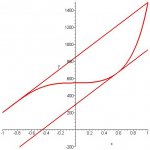For For the hyperbolic function sinh(x^3+7) Find the value of c which verifies the mean value theorem where a = -1 and b = 1. This is what I have:
f'(c)=(f(b)-f(a))/(b-a); f'(c)=(f(1)-f(-1))/(1--1); f'(c)=(f(1)-f(-1))/2;
f(1) = [(e^(1+7) - (e^(-1+7)]/2 = 1288.76
f(-1) = [(e^(-1+7) - (e^(1+7)]/2 = -1288.76
f'(c)=( 1288.76 - - 1288.76)/2; f'(c)= 1288.76; 3x^2cosh(x^3+7) = 1288.76
I don't know how to solve for f'(c) at 1288.76 assuming I am correct up to that point
f'(c)=(f(b)-f(a))/(b-a); f'(c)=(f(1)-f(-1))/(1--1); f'(c)=(f(1)-f(-1))/2;
f(1) = [(e^(1+7) - (e^(-1+7)]/2 = 1288.76
f(-1) = [(e^(-1+7) - (e^(1+7)]/2 = -1288.76
f'(c)=( 1288.76 - - 1288.76)/2; f'(c)= 1288.76; 3x^2cosh(x^3+7) = 1288.76
I don't know how to solve for f'(c) at 1288.76 assuming I am correct up to that point

